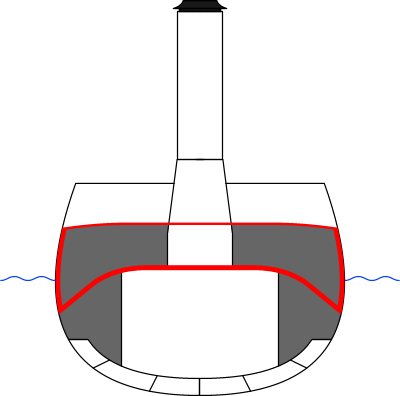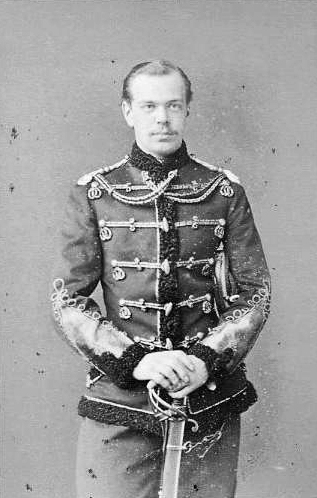|
Russian Cruiser Admiral Nakhimov (1885)
''Admiral Nakhimov'' (russian: italic=yes, Адмирал Нахимов), was an armoured cruiser in the Imperial Russian Navy during the Russo-Japanese War. She was named after Admiral Pavel Nakhimov. Construction ''Admiral Nakhimov'' was ordered in 1881 as one of the first armoured cruisers. She was modeled after the British Royal Navy cruisers, which were armed with four 234 mm guns in a rhomboid layout. ''Admiral Nakhimov'' was considered a more successful design. Her main armament consisted of 203 mm guns, which were lighter and their number could be doubled. As a result, ''Admiral Nakhimov'' had probably the heaviest broadside (six 203 mm guns and five 152 mm guns) of all the armoured cruisers built in the 19th century. Unfortunately, her guns quickly became obsolete. Consideration was given to replacing them with quick-firing 152 mm guns (with eleven in a broadside), but it was not done due to the limited resources of Russian industry before the wa ... [...More Info...] [...Related Items...] OR: [Wikipedia] [Google] [Baidu] |
Pavel Nakhimov
Pavel Stepanovich Nakhimov (russian: Павел Степанович Нахимов, ; – ) was a Russian Admiral in the Imperial Russian Navy known for his victory in the Battle of Sinop and his leadership in the Siege of Sevastopol (1854–1855) during the Crimean War. He joined the imperial Russian Navy and moved up the ranks serving in the Greek War of Independence and the Russo-Turkish War (1828–29). At the beginning of the Crimean War, he delivered a significant victory at the Battle of Sinop against the Ottoman Empire. Afterward, he was a leader in the defense of Sevastopol against British, French, and Ottoman forces, during which a sniper wounded him, and he died a few days later. After his death, he became a hero in Russia, with medals and ships named after him, especially during Soviet times, starting with Stalin. Also, a Soviet Film called '' Admiral Nakhimov'' was made in 1947 about his life. Early life Nakhimov was born in the village of Gorodok in t ... [...More Info...] [...Related Items...] OR: [Wikipedia] [Google] [Baidu] |
Armoured Cruiser
The armored cruiser was a type of warship of the late 19th and early 20th centuries. It was designed like other types of cruisers to operate as a long-range, independent warship, capable of defeating any ship apart from a battleship and fast enough to outrun any battleship it encountered. For many decades, naval technology had not advanced far enough for designers to produce a cruiser which combined an armored belt with the long range and high speed required to fulfill its mission. For this reason, beginning in the 1880s and 1890s, many navies preferred to build protected cruisers, which only relied on a light armored deck to protect the vital parts of the ship. However, by the late 1880s, the development of modern rapid-fire breech-loading cannon and high-explosive shells made the reintroduction of side armor a necessity. The invention of face-hardened armor in the mid-1890s offered effective protection with less weight than previously. Varying in size, the armored cruiser was ... [...More Info...] [...Related Items...] OR: [Wikipedia] [Google] [Baidu] |
Flagship
A flagship is a vessel used by the commanding officer of a group of naval ships, characteristically a flag officer entitled by custom to fly a distinguishing flag. Used more loosely, it is the lead ship in a fleet of vessels, typically the first, largest, fastest, most heavily armed, or best known. Over the years, the term "flagship" has become a metaphor used in industries such as broadcasting, automobiles, education, technology, airlines, and retail to refer to their highest profile or most expensive products and locations. Naval use In common naval use, the term ''flagship'' is fundamentally a temporary designation; the flagship is wherever the admiral's flag is being flown. However, admirals have always needed additional facilities, including a meeting room large enough to hold all the captains of the fleet and a place for the admiral's staff to make plans and draw up orders. Historically, only larger ships could accommodate such requirements. The term was also used by ... [...More Info...] [...Related Items...] OR: [Wikipedia] [Google] [Baidu] |
Vladivostok
Vladivostok ( rus, Владивосто́к, a=Владивосток.ogg, p=vɫədʲɪvɐˈstok) is the largest city and the administrative center of Primorsky Krai, Russia. The city is located around the Zolotoy Rog, Golden Horn Bay on the Sea of Japan, covering an area of , with a population of 600,871 residents as of 2021. Vladivostok is the second-largest city in the Far Eastern Federal District, as well as the Russian Far East, after Khabarovsk. Shortly after the signing of the Treaty of Aigun, the city was founded on July 2, 1860 as a Russian military outpost on formerly Chinese land. In 1872, the main Russian naval base on the Pacific Ocean was transferred to the city, stimulating the growth of modern Vladivostok. After the outbreak of the Russian Revolution in 1917, Vladivostok was Allied intervention in the Russian Civil War, occupied in 1918 by White Russian and Allies_of_World_War_I, Allied forces, the last of whom from Japan were not withdrawn until 1922; by that tim ... [...More Info...] [...Related Items...] OR: [Wikipedia] [Google] [Baidu] |
Kronstadt
Kronstadt (russian: Кроншта́дт, Kronshtadt ), also spelled Kronshtadt, Cronstadt or Kronštádt (from german: link=no, Krone for "crown" and ''Stadt'' for "city") is a Russian port city in Kronshtadtsky District of the federal city of Saint Petersburg, located on Kotlin Island, west of Saint Petersburg, near the head of the Gulf of Finland. It is linked to the former Russian capital by a combination levee-causeway-seagate, the St Petersburg Dam, part of the city's flood defences, which also acts as road access to Kotlin island from the mainland. Founded in the early 18th century by Peter the Great, it became an important international centre of commerce whose trade role was later eclipsed by its strategic significance as the primary maritime defence outpost of the former Russian capital. Kaplan, 1995 The main base of the Russian Baltic Fleet was located in Kronstadt, guarding the approaches to Saint Petersburg. In March 1921, the island city was the site of the Krons ... [...More Info...] [...Related Items...] OR: [Wikipedia] [Google] [Baidu] |
Russian Pacific Fleet
, image = Great emblem of the Pacific Fleet.svg , image_size = 150px , caption = Russian Pacific Fleet Great emblem , dates = 1731–present , country = , allegiance = (1703–1917) (1922–1991) (1991–present) , branch = Russian Navy , type = , role = At sea nuclear deterrence;Naval warfare; Amphibious military operations;Combat patrols in the Pacific/Arctic;Naval presence/diplomacy missions in the Pacific and elsewhere , size = c. 46 Surface Warships (major surface units, light corvettes, mine warfare, amphibious) plus support ships/auxiliaries c. 23-24 Submarines (of which about 2/3 active as of 2022) , command_structure = Russian Armed Forces , garrison = Fokino (HQ)Petropavlovsk-Kamchatsky Vilyuchin ... [...More Info...] [...Related Items...] OR: [Wikipedia] [Google] [Baidu] |
Alexander III Of Russia
Alexander III ( rus, Алекса́ндр III Алекса́ндрович, r=Aleksandr III Aleksandrovich; 10 March 18451 November 1894) was Emperor of Russia, King of Poland and Grand Duke of Finland from 13 March 1881 until his death in 1894. He was highly reactionary and reversed some of the liberal reforms of his father, Alexander II. This policy is known in Russia as "counter-reforms" ( rus, контрреформы). Under the influence of Konstantin Pobedonostsev (1827–1907), he opposed any reform that limited his autocratic rule. During his reign, Russia fought no major wars; he was therefore styled "The Peacemaker" ( rus, Миротворец, Mirotvorets, p=mʲɪrɐˈtvorʲɪt͡s). It was he who helped forge the Russo-French Alliance. Personality Grand Duke Alexander Alexandrovich was born on 10 March 1845 at the Winter Palace in Saint Petersburg, Russian Empire, the second son and third child of Tsesarevich Alexander (Future Alexander II) and his first wife ... [...More Info...] [...Related Items...] OR: [Wikipedia] [Google] [Baidu] |
Tsar
Tsar ( or ), also spelled ''czar'', ''tzar'', or ''csar'', is a title used by East Slavs, East and South Slavs, South Slavic monarchs. The term is derived from the Latin word ''Caesar (title), caesar'', which was intended to mean "emperor" in the European medieval sense of the term—a ruler with the same rank as a Roman emperor, holding it by the approval of another emperor or a supreme ecclesiastical official (the Pope or the Ecumenical Patriarch)—but was usually considered by western Europeans to be equivalent to "king". It lends its name to a system of government, tsarist autocracy or tsarism. "Tsar" and its variants were the official titles of the following states: * Bulgarian Empire (First Bulgarian Empire in 681–1018, Second Bulgarian Empire in 1185–1396), and also used in Kingdom of Bulgaria, Tsardom of Bulgaria, in 1908–1946 * Serbian Empire, in 1346–1371 * Tsardom of Russia, in 1547–1721 (replaced in 1721 by ''imperator'' in Russian Empire, but still re ... [...More Info...] [...Related Items...] OR: [Wikipedia] [Google] [Baidu] |
Baltic Shipyard
The OJSC Baltic Shipyard (''Baltiysky Zavod'', formerly Shipyard 189 named after Grigoriy Ordzhonikidze) (russian: Балтийский завод имени С. Орджоникидзе) is one of the oldest shipyards in Russia and is part of United Shipbuilding Corporation today. It is located in Saint Petersburg in the south-western part of Vasilievsky Island. It is one of the three shipyards active in Saint Petersburg. Together with the Admiralty Shipyard it has been responsible for building many Imperial Russian battleships as well as Soviet nuclear-powered icebreakers. Currently it specializes in merchant ships while the Admiralty yard specializes in diesel-electric submarines. In addition, it is responsible for construction of Russian floating nuclear power stations. History The shipyard was founded in 1856 by the St. Petersburg merchant M. Carr and the Scotsman Murdoch. L. MacPherson. It subsequently became the Carr and MacPherson yard. In 1864 it built two monitors ... [...More Info...] [...Related Items...] OR: [Wikipedia] [Google] [Baidu] |
Torpedo
A modern torpedo is an underwater ranged weapon launched above or below the water surface, self-propelled towards a target, and with an explosive warhead designed to detonate either on contact with or in proximity to the target. Historically, such a device was called an automotive, automobile, locomotive, or fish torpedo; colloquially a ''fish''. The term ''torpedo'' originally applied to a variety of devices, most of which would today be called naval mine, mines. From about 1900, ''torpedo'' has been used strictly to designate a self-propelled underwater explosive device. While the 19th-century battleship had evolved primarily with a view to engagements between armored warships with naval artillery, large-caliber guns, the invention and refinement of torpedoes from the 1860s onwards allowed small torpedo boats and other lighter surface combatant , surface vessels, submarines/submersibles, even improvised fishing boats or frogmen, and later light aircraft, to destroy large shi ... [...More Info...] [...Related Items...] OR: [Wikipedia] [Google] [Baidu] |
Brig
A brig is a type of sailing vessel defined by its rig: two masts which are both square rig, square-rigged. Brigs originated in the second half of the 18th century and were a common type of smaller merchant vessel or warship from then until the latter part of the 19th century. In commercial use, they were gradually replaced by fore-and-aft rigged vessels such as schooners, as owners sought to reduce crew costs by having rigs that could be handled by fewer men. In Royal Navy use, brigs were retained for training use when the battle fleets consisted almost entirely of iron-hulled steamships. Brigs were prominent in the coasting coal trade of British waters. 4,395 voyages to London with coal were recorded in 1795. With an average of eight or nine trips per year for one vessel, that is a fleet of over 500 colliers trading to London alone. Other ports and coastal communities were also be served by colliers trading to Britain's coal ports. In the first half of the 19th century, the va ... [...More Info...] [...Related Items...] OR: [Wikipedia] [Google] [Baidu] |









